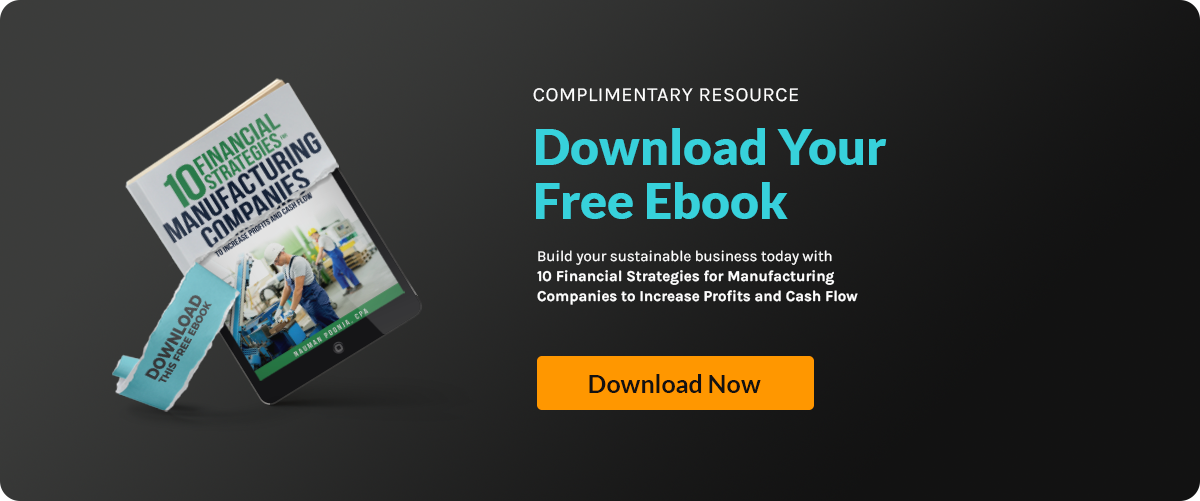Every decision in manufacturing comes with a trade-off. Invest in new equipment, and you might...
Top Capital Efficiency Strategies for Manufacturing Businesses

"Efficiency is doing better than what is already being done." In manufacturing, Peter Drucker's principle is paramount. A study shows that companies focusing on capital efficiency can see a 30% increase in operational performance.
How does your business measure up? Are you leveraging every opportunity to enhance your capital efficiency? This blog is crafted for manufacturing business owners like you who aspire to meet and exceed industry standards. We invite you to read on and discover strategies that can transform your capital efficiency and elevate your business.
What is Capital Efficiency?
Capital efficiency measures how well a company uses capital to generate profits, crucial for investor appeal and business growth. It involves calculating the return on capital (ROC) by dividing earnings before interest and taxes (EBIT) by the capital employed.
High ROC indicates efficient use of resources, generating substantial recurring revenue without burning money. Investors favor companies that efficiently turn investments into profits, ensuring sustained growth. By focusing on this aspect, businesses can make smarter investments, boost profitability, and attract more investment.
But capital efficiency isn’t just about racking up impressive numbers; it’s about resilience. When markets hit a rough patch or the sales pipeline slows down, capital efficiency extends your runway. It’s not only about how much recurring revenue you bring in, but also how wisely leadership steers decision-making—especially when tempted by flashy marketing campaigns or aggressive hiring. Overspending now can lead to painful cutbacks later, a signal that growth wasn’t as sustainable as it seemed.
Think of this strategy as the sturdy backbone of your financial health. Without it, even the most innovative manufacturing techniques can stumble. But with it, your company can thrive in ways you never thought possible. Efficient capital use isn’t just a strategy; it’s a philosophy that turns every investment into a gold mine.
How ROCE Stands Apart: Comparing Capital Efficiency Metrics
When it comes to measuring how skillfully a business converts capital into profit, Return on Capital Employed (ROCE) is a longtime favorite—especially in the manufacturing sector and among public companies. But how does ROCE differ from other capital efficiency metrics, and when does it truly shine?
ROCE focuses on the overall profit generated from every dollar of capital used. It’s calculated by dividing earnings before interest and taxes (EBIT) by the capital employed (total assets minus current liabilities). This provides a high-level snapshot of how well your total resources are driving profits back to stakeholders over a specific period.
Where ROCE Makes Its Mark:
- Best for larger, established businesses: ROCE is most informative for companies with steady operations, such as mature manufacturers or public enterprises. It gives investors and business leaders a way to compare profitability among peers.
- Useful for market benchmarking: Comparing your company's ROCE to competitors can reveal whether you’re leading the charge in efficiency or need to up your game.
- Holistic view: ROCE takes into account all capital at work—not just invested funds or equity—making it a comprehensive gauge of long-term business health.
How ROCE Differs from Other Metrics:
- Return on Invested Capital (ROIC): While similar, ROIC zooms in more narrowly on returns from capital that’s actively being used for growth and operations, offering insight into investment decisions.
- Return on Assets (ROA): ROA considers all company assets, including those financed by debt, so it generally paints a broader (sometimes less focused) picture.
- Return on Equity (ROE): ROE zeroes in on returns just for shareholders, excluding the impact of debt and other financing sources—great for equity investors but less telling for overall operational efficiency.
- Limitations: ROCE isn’t ideal for early-stage startups or companies hoarding significant unused cash, as it can skew the picture of efficiency.
By knowing when and where to use ROCE, you ensure your capital efficiency analysis is on point—yielding insights that lead to smarter investments and smarter growth.
What is the Burn Multiple?
When it comes to measuring capital efficiency, especially during challenging market conditions, the burn multiple offers a clear lens. Popularized by David Sacks of Craft Ventures, this metric examines how much capital a company is "burning" to generate each additional dollar of revenue.
In simple terms, the burn multiple is calculated by dividing your net cash burn by your net new revenue. Unlike other metrics that hone in on specific areas like marketing or sales, the burn multiple takes a holistic view, tracking how every business decision—from operations to expansion—affects your cash outflow versus your revenue growth.
Why does this matter for manufacturers and business owners aiming to sharpen their capital efficiency? Because the lower your burn multiple, the more efficiently you're converting cash spent into real, sustainable revenue. Whether you're tracking it monthly, quarterly, or annually, this metric serves as an early-warning system: it highlights whether your growth is truly sustainable or needs some tightening up.
Analyzing your burn multiple helps ensure that each dollar invested works harder for your business, protecting your runway while fueling healthy growth.
Key Capital Efficiency Metrics in SaaS
When it comes to capital efficiency in SaaS, measuring success goes far beyond a single number on a spreadsheet. There are a handful of specialized metrics that can reveal how effectively your business transforms invested capital into recurring revenue. Let’s walk through the main ones, each offering its own unique lens on performance.
- Cash Conversion Score: Especially relevant for SaaS companies, this metric shows how well your raised capital (from equity, debt, or other sources) is converting into annual recurring revenue (ARR). The higher your cash conversion score, the more efficiently each dollar invested turns into reliable, top-line revenue. This acts as a quick litmus test for how hard your capital is working for you.
- Burn Multiple: Crafted in tough markets by David Sacks at Craft Ventures, the burn multiple is all about discipline. It takes your net cash burned in a period and stacks it against the net new ARR you’ve added in that time. A lower burn multiple means you’re generating more revenue growth per dollar burned—a sure sign of capital efficiency.
- Return on Capital Employed (ROCE): The bedrock metric for mature businesses, ROCE measures how effectively you’ve used your total capital (assets minus current liabilities) to generate operating profits. In SaaS, a robust ROCE signals that your business is not just growing, but doing so sustainably without excessive cash burn.
- Bessemer’s Efficiency Score: Tailored for the high-growth, high-burn environment of startups, this metric takes your net new ARR and divides it by your net burn. The result highlights just how much of your spend is translating into real, repeatable revenue, guiding decisions around scaling and investment.
- Hype Ratio: Introduced by Dave Kellogg, the hype ratio blends the art and science of SaaS growth. It’s calculated by dividing your capital raised (or spent) by your ARR. While a low ratio is generally preferred, a certain amount of ‘hype’ can attract investor attention and fuel further growth. Think of it as a measure of buzz—but grounded in the hard numbers of capital efficiency.
- CAC Ratio: Your Customer Acquisition Cost (CAC) ratio offers a micro-level view of efficiency by comparing how much you spend to bring in each new customer against the revenue they generate. Pairing the CAC ratio with your CAC payback period—the time it takes for a new customer to become profitable—helps you pinpoint which marketing and sales activities are truly pulling their weight, and which might need a tune-up.
- Customer Lifetime Value (LTV): LTV gets to the heart of customer excitement and loyalty, measuring the average revenue you’ll earn from a customer over their relationship with your company. A healthy, long LTV means customers are sticking around, renewing, upgrading, and referring others. This metric not only sets the tone for your CAC and payback calculations, but also shapes your retention and upsell strategies.
- Human Capital Efficiency: Don’t overlook the people side of the equation. Human capital efficiency evaluates revenue per employee (or full-time equivalent), giving you insight into how well your team’s efforts are translating into ARR. It’s a powerful way to ensure your growth ambitions remain aligned with your staffing plans and capital allocation.
- SaaS Magic Number: The SaaS magic number digs into sales efficiency, answering the key question: “How much revenue do we generate from our sales and marketing spend?” It’s a holistic way to evaluate growth momentum over a given period, helping you spot whether you’re scaling efficiently or burning through resources too quickly.
Each of these metrics looks at capital efficiency from a slightly different angle, but together, they give you a comprehensive picture of how smartly your business is turning investment into sustainable, recurring success. By weaving together the big-picture scores and the granular ratios, you can diagnose bottlenecks, optimize for growth, and ensure every dollar is working overtime for your SaaS business.
Streamlining Capital Efficiency Tracking
So, let’s get real: tracking capital efficiency shouldn’t feel like wrangling a wild spreadsheet rodeo. The truth is, pulling together accurate, up-to-date data across your systems can be a headache—one that leaves you staring at stale numbers long after the moment has passed. But sharp operators know that the right approach can move you from reacting to old data to actually steering the ship.
The modern answer to this challenge? Integrating your core financial, sales, and operational tools so that data flows together seamlessly. Whether you rely on Salesforce for revenue tracking, NetSuite for accounting, or custom dashboards built with Looker or Tableau, the playbook is the same:
- Automate Data Collection: Connect your systems to minimize manual entry. Tools with robust APIs, like QuickBooks or HubSpot, can send data straight to your dashboards with little friction.
- Centralize Analysis: Bring all your metrics—burn multiple, cash conversion score, ROCE, efficiency ratios—into a single source of truth. Platforms like Power BI or Google Data Studio let you pull everything into one place, so decision-makers view exactly what matters in real time.
- Customize Your Dashboards: Set up tailored reports focused on the KPIs that drive your business. Whether you want a big-picture overview or want to dig into cohort-specific trends, a few clicks should get you there. Pre-built templates can be a godsend for ramping up quick insights, but customizable views keep pace with your evolving questions.
- Leverage Real-Time Collaboration: Empower leaders and teams to explore the metrics themselves, layer in forecasts, and spot trends before they cost you runway. The days of waiting for quarterly reviews are over—adopt tools that keep everyone on the same page, all the time.
By taking the time to streamline your capital efficiency monitoring, you free your team from spreadsheet mayhem and focus on strategic moves that truly impact growth. A crisp, up-to-the-minute view of your capital efficiency turns you from a firefighter into a navigator—primed to make smarter, faster decisions.
Understanding Bessemer’s Efficiency Score Benchmarks
So, how do you actually interpret Bessemer’s Efficiency Score in the wild? While the calculation itself is simple—divide your net new ARR by your net cash burn—the story really comes alive in the benchmarks.
- Less than 0.5x (Good): If your score falls below 0.5x, you’re operating with caution—burning more than you’re pulling in. This isn’t always a bad place for early-stage startups aiming for accelerated growth, but it’s a sign to monitor your burn rate carefully, especially if market conditions tighten.
- 0.5x to 1.5x (Better): Land in this middle range and you’re striking a solid balance. Your capital is fueling recurring revenue at a respectable clip, pointing to sensible spending and a growth engine that isn’t guzzling fuel. Most SaaS businesses strive to live within this zone, signaling to investors that your business model scales without excessive risk.
- Above 1.5x (Best): Now we’re talking robust efficiency. Here, every dollar of net burn is matched by more than $1.50 in net new ARR. It’s rarefied air, often reserved for breakout performers or businesses hitting their stride with capital-light growth. Reaching this level means you’ve dialed in your capital deployment and can weather market headwinds with confidence.
Keep in mind, the real insight comes from tracking your score over multiple quarters. A steadily climbing efficiency score signals that your strategic investments are paying off, while any significant dips can cue a closer look at how capital is being put to work.
Recommended Benchmarks for Capital Efficiency in SaaS
So, what targets should you aim for when sizing up your own capital efficiency ratios in SaaS? While the “right” number can vary depending on your company’s stage, business model, and market conditions, there are industry yardsticks worth keeping in mind.
A common rule of thumb is that a capital efficiency ratio (often calculated as net new ARR divided by net burn) of 1.0 is solid—meaning each dollar burned creates a dollar of recurring revenue. However, if you want to stand out as a top performer (and catch the attention of investors like those at Bessemer Venture Partners), ratios closer to 2:1 or even 3:1 are considered excellent. In other words, for every dollar spent, you’re generating two or three dollars in recurring revenue—a clear sign your capital is working overtime.
Of course, early-stage startups might see lower ratios as they invest heavily in growth, while mature SaaS businesses with established revenue streams should push for higher efficiency benchmarks. Always remember to view these targets within the context of your growth strategy and industry peers—capital efficiency is all about striking the right balance between investment and sustainable returns.
How Cash Conversion Score Stands Apart
Now, while all capital efficiency formulas aim to measure how well you’re stretching each dollar invested, the cash conversion score brings its own flavor to the mix—especially for SaaS businesses.
Unlike broader metrics, the cash conversion score zeroes in on how effectively your cumulative raised capital (from equity, debt, you name it) has translated into top-line recurring revenue. In practice, you get this number by taking your current annual recurring revenue (ARR) and dividing it by the net capital deployed—think: all capital raised so far, minus whatever cash is still lounging around on your balance sheet.
What sets this score apart is its clear focus on recurring revenue per invested dollar, providing a straightforward ratio that can be benchmarked across the industry. For instance, Bessemer Venture Partners uses the 0.25x to 1.0x+ scale to categorize companies’ efficiency: anything at 1.0x or above is the stuff of SaaS legends.
Where other formulas, such as the burn multiple or ROCE, may fold in profitability, operating margins, or capex, the cash conversion score acts as a real-time litmus test for capital deployment into ARR—no waiting around for end-of-year reports or P&Ls to trickle in. It strips out the noise, putting the spotlight squarely on whether your raised dollars are actually pulling their weight, not just generating a quick burst of growth.
In short: while all capital efficiency formulas have their own use cases, the cash conversion score makes it simple to see exactly how much recurring revenue you’re squeezing out of every dollar invested. For founders and finance teams, it’s an incredibly practical way to gauge traction and set the bar for “good, better, best”—especially when you’re eyeing that next funding round or ramping up go-to-market.
Understanding Cash Conversion Score Benchmarks
So what do those cash conversion score bands—Good, Better, Best—really tell you? Think of them as your capital efficiency speedometer.
- Good (0.25x–0.5x): If your cash conversion score falls in this range, your invested capital is pulling respectable weight, generally implying strong returns—think around a 40% internal rate of return. This suggests your business is making decent headway from every dollar put in.
- Better (0.5x–1.0x): Landing here means you’re hitting your stride, squeezing even more value out of your capital. Returns can climb to about 80%. It’s a sweet spot for companies scaling efficiently and typically signals healthy traction in both market fit and execution.
- Best (1.0x or higher): This level is the gold standard for SaaS—your capital is not just working, it's soaring, with potential internal rates of return north of 120%. Hitting this benchmark is a strong indicator that your product, go-to-market strategy, and operations are all aligned for sustainable, compounding growth.
While cash conversion score isn’t itself the full story behind your ROI, watching how it trends over time can reveal much about the underlying health and scalability of your business. If your score consistently improves, it often points to strategic shifts—like nailing product/market fit or dialing in your sales and marketing mix—as your business matures.
How Efficient Capital Allocation Impacts ROIC
Efficient capital allocation plays a pivotal role in enhancing a company’s return on invested capital (ROIC). By strategically directing resources toward areas with the highest potential for growth and profitability, businesses can boost their financial performance and increase shareholder value.
Here's how it works:
- Maximizes Returns: Allocating capital effectively ensures that funds are invested in projects that offer the greatest returns. This could mean focusing on innovation, expanding into new markets, or improving operational efficiency.
- Minimizes Waste: By avoiding investments in low-yield projects, companies prevent the misuse of resources, safeguarding finances and optimizing available funds.
- Competitive Edge: Companies that refine their capital allocation strategies often outperform competitors. This enhances their market position, leading to improved financial metrics, including a superior ROIC.
Evaluating ROIC against the weighted average cost of capital (WACC) provides a clear measure of capital utilization. If a company’s ROIC is higher than its WACC, it indicates that the business is successfully generating value from its investments. Conversely, if the ROIC falls short, the company may need to reassess its strategy to avoid resource drain on ineffective investments.
Effective Financial Management
Effective financial management is the backbone of any capital-efficient business. It ensures that every dollar spent contributes to the company's growth and profitability.
Here are five key strategies:
Track Key Financial Ratios
Understanding and regularly reviewing key metrics, such as the capital efficiency ratio and return on capital employed (ROCE), is crucial. These ratios help assess how efficiently a company uses capital to generate profits.
Control Burn Rate
For startups and established businesses, managing the burn rate—the rate at which a company spends its capital—is essential. Keeping this under control within a given period ensures that resources are used wisely and helps avoid financial crises.
Benchmarking
Compare your company's performance against industry standards. Benchmarking helps identify areas where you can improve efficiency. It also provides a clear calculation of where your business stands.
Optimize Sales and Marketing Spend
Effective allocation of funds towards sales and marketing can significantly impact your efficiency score. Investing in high-return activities while minimizing low-impact expenses is key.
Improve Cash Conversion Cycle
Enhancing your cash conversion score by speeding up the process from sales to cash collection improves your overall profitability. This metric is a critical indicator of how well your business manages its working capital.
Common Pitfalls in Achieving Capital Efficiency
Achieving capital efficiency is essential for sustained growth and long-term value, but it's not always straightforward. Several common pitfalls can undermine these efforts.
Misaligned Capital Allocation
One major issue is poor alignment between capital allocation and strategic goals. This occurs when funds are invested based on historical success rather than future potential. For example, pouring money into a mature sector with diminishing returns instead of exploring new, innovative ventures can stall growth and hamper progress.
Overly Rigid Investment Planning
Another frequent pitfall is an inflexible investment plan. Many companies stick to strict planning processes, which can trap them in long-term commitments. This rigidity often inhibits their ability to pivot in response to market fluctuations or seize emerging opportunities, which can weaken competitive advantage.
Inefficient Execution
Even with optimal resource allocation, execution difficulties can derail capital efficiency. Problems often stem from inadequate teamwork across departments, poor project management, or ineffective investment tracking. These issues can cause delays, inflate costs, and ultimately fall short of delivering expected returns.
By identifying these pitfalls, companies can better navigate the challenges of achieving capital efficiency. The ability to adapt and execute strategy effectively remains crucial in maintaining a competitive edge.
Maximizing Resources in Manufacturing Business
Maximizing resources is essential for manufacturing businesses aiming for higher capital efficiency. Efficient resource utilization ensures that companies can operate and grow sustainably. Manufacturing businesses must focus on maximizing both financial and human resources.
Here are seven strategies to consider:
Enhance Human Capital Efficiency
Invest in training and development programs to boost employee productivity. Human capital efficiency is a critical metric that impacts your overall profitability.
Monitor Key Capital Efficiency Metrics
Track metrics such as return on capital efficiency and cash burn regularly. These metrics help you understand how efficiently your company uses its resources to generate revenue.
Adopt a Forward-Thinking Business Model
Evaluate your business model and maturity to ensure scalability. A forward-thinking approach prepares your business for future success and helps maintain a positive growth trajectory.
Improve Customer Acquisition Strategies
Focus on efficient customer acquisition techniques to increase annual recurring revenue. Effective strategies here can lead to significant revenue growth.
Calculate and Leverage Your Burn Multiple
When economic conditions tighten, understanding your burn multiple becomes essential for safeguarding your business’s future. The burn multiple is a straightforward yet powerful metric: it measures how efficiently your company is transforming cash burn into new revenue.
To calculate it, simply divide your net cash burned over a set period (usually a month or a quarter) by the net new revenue generated during the same time frame:
Burn Multiple = Net Cash Burned / Net New Revenue
For example, if your company burned $500,000 in a quarter and added $1 million in new revenue, your burn multiple is 0.5. Lower is better—it means you’re generating more revenue per dollar spent, a sign of savvy capital efficiency.
Why does this matter in a downturn? Unlike metrics that only look at sales or marketing, the burn multiple zooms out to include every business action, from operational changes to strategic pivots. This holistic view helps you extend your runway and forces smarter decision-making. Especially when funding tightens, tracking your burn multiple helps prioritize investments that have the greatest impact, positioning your business to weather uncertain times and emerge stronger.
Invest Capital at the Right Time
Capital efficiency isn’t just about reducing costs—it’s about knowing when and where to invest for optimal growth. For example, early-stage companies often need to prioritize building a great product before ramping up sales and marketing teams. By aligning capital investments with your business’s stage and strategic priorities, you avoid the trap of “growth at literally all costs” and instead work toward a steady, sustainable growth plan.
Thoughtful capital allocation means you’re empowering your engineering team to deliver a solid product foundation before fully launching go-to-market efforts. This approach ensures that every dollar spent is driving your company closer to its next milestone, rather than fueling unnecessary overhead or premature scaling.
Implement Quarterly Evaluations
Conduct thorough quarterly evaluations of your metrics. This will help you track and improve your company's performance and ensure that capital efficiency remains a priority.
Implement Quarterly Evaluations
Conduct thorough quarterly evaluations of your metrics. This will help you track and improve your company's performance and ensure that capital efficiency remains a priority.
Prepare for Market Changes
Stay adaptable and ready for changes in market conditions. By understanding how much revenue you need to generate under different scenarios, you can make informed decisions that support your business's stability and growth.
Enhancing Profitability
Enhancing profitability is a key goal for any manufacturing business. Manufacturers can improve their financial performance across the board by focusing on various strategies.
Here are five steps to consider:
Step 1: Adopt a Holistic Approach
Take a broad view of your operations, considering how different areas impact overall financial performance. This umbrella-term approach ensures that no aspect of your business is overlooked.
Step 2: Focus on Growing Revenue
Implement strategies to increase sales and expand market reach. Growing revenue is a solid bet for improving profitability and scaling your business effectively.
Step 3: Evaluate Cost Structures
Regularly review your cost structures to identify areas where expenses can be reduced without compromising quality.
For example, a company invested in automating parts of their production line, initially spending $ 1 million. This led to a reduction in fixed costs and improved efficiency, resulting in a net profit increase. This step is crucial to see whether your operations are as efficient as possible.
Step 4: Enhance Workforce Efficiency
Invest in your employees to boost productivity and reduce the need for layoffs. A motivated and efficient workforce contributes significantly to better financial performance.
Step 5: Monitor Financial Health
Continuously track your financial metrics to ensure they align with your profitability goals. This includes checking for areas that might dilute profits and making necessary adjustments.
Ensuring Sustained Success
Sustained success in the manufacturing sector hinges on effective capital use. By focusing on capital efficiency, businesses can maintain a strong financial position and foster long-term growth.
Here are three essential strategies manufacturing businesses need to leverage their capital efficiently:
Optimize Sales Efficiency
Improving sales efficiency ensures that every dollar invested in sales and marketing yields maximum returns. Successful companies continuously refine their sales processes to boost overall profitability.
Regularly Review and Adjust Capital Allocation
Periodically assess how your invested capital is being used. Adjustments based on current performance and market conditions can improve annualized returns and enhance your company's valuation. This ensures that capital is always being used efficiently.
Invest in Long-Term Growth
Focus on investments that promise sustainable, long-term growth. It’s getting increasingly important for manufacturers to prioritize projects and innovations that drive future success, ensuring they remain competitive and financially stable over time.
Boost Your Business Growth—Partner with Accounovation for Top Capital Efficiency Strategies
Capital efficiency is the secret sauce to scaling your business and maximizing profits. In today's competitive market, using your resources wisely can make all the difference. Don't let inefficiencies hold you back when smarter strategies can propel you forward.
At Accounovation, we specialize in crafting tailored capital efficiency strategies that fit your unique business needs. Our expertise ensures you get the most bang for your buck, driving sustainable growth and profitability.
Ready to take your business to new heights? Contact Accounovation today and let’s make your capital work harder for you!
Frequently Asked Questions
What are the critical strategies for improving financial management in manufacturing businesses?
Key strategies include implementing lean manufacturing principles, optimizing inventory management, investing in automation, conducting regular financial audits, and focusing on cost reduction initiatives.
How can manufacturing companies maximize their financial resources?
Companies can maximize their financial resources by streamlining operations, adopting energy-efficient technologies, renegotiating supplier contracts, and utilizing data analytics to identify cost-saving opportunities.
What role does technology play in enhancing manufacturing's financial performance?
Technology plays a crucial role by enabling real-time monitoring of production processes, improving supply chain management, reducing waste, and facilitating predictive maintenance, all of which contribute to better financial performance.
How can lean manufacturing principles help in better financial utilization?
Lean manufacturing principles help eliminate waste, improve process flows, enhance product quality, and reduce lead times, which collectively lead to better financial utilization and increased profitability.
What are the benefits of optimizing inventory management for manufacturing businesses?
Optimizing inventory management can reduce holding costs, minimize stockouts, improve cash flow, and better align production with demand, ultimately contributing to improved financial outcomes.







